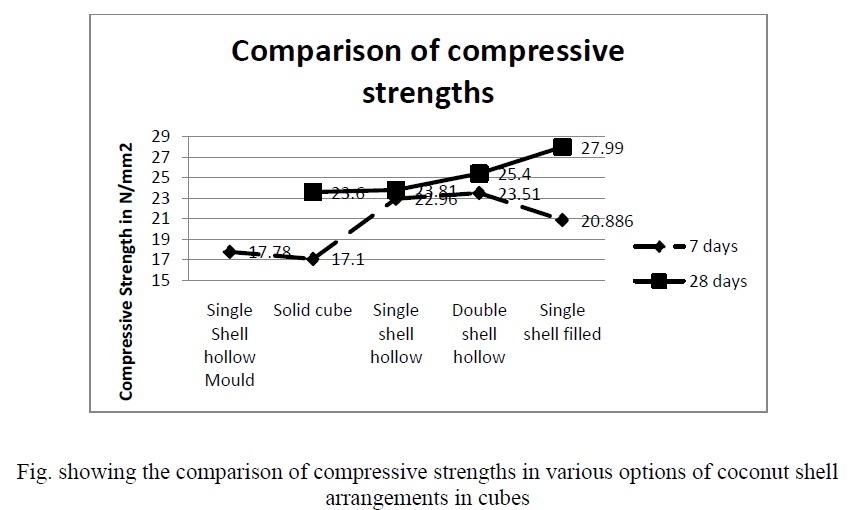





Published on Nov 30, 2023
Due to rapid growth of construction activities, conventional aggregate sources are depleting at a very fast pace, leading to significant increase in cost of construction. For sustainable development, these materials should be used wisely, and alternative cost effective and eco-friendly materials need to be studied for its various characteristics as building materials. Variety of waste materials, organic and inorganic has been successfully used in various building materials such as concrete, building blocks, flush door, plywood etc. India being third largest producer of coconut shells creates a major problem of solid waste too. But its high strength modulus, natural shell structure and the non-biodegradable pentosans chemical constituents’ can be utilised for using coconut shell as an alternative for coarse aggregates, reinforcement, filler, thermal insulating material, hollow structure provider, etc., in building blocks and concrete technology.
Keywords : Coconut shells, Building blocks, Hollow Blocks, Filler Material, solid waste management.
1. To study and analyse the engineering properties of Coconut shell to use it as an alternate eco-friendly material in producing cost effective building blocks or concrete.
2. To study and evaluate the strength properties of coconut shell based concrete building blocks viz: hollow and filled blocks with various options of shells orientations to understand its capability to be used as a filler/composite/reinforcement material.
In order to achieve these objectives, standard test such as compressive strength in dry condition on different dome shaped coconut shells have been carried out. A suitable mix design has been derived presuming a moderate exposure condition for the blocks. With a mix proportion of M25 (1:1:2) concrete, standard cubes of 15 cm dimensions have been prepared for the analysis. About 12 hollow cubes, 6 solid cubes and 6 hollow cylinders with coconut shell as a filler and composite in different spatial orientation, and with varying numbers/quantity have been tested for its various strength parameters such as compressive strength, Split tensile strength, etc., for different periods of curing
After these tests, compressive strength of bare dome shaped coconut shells was found to be 15 KN indicating that it can be used as filler materials thanks to its natural dome shape and its durable chemical constituents. Moreover its pleasing finished look can even be used for slabs to give aesthetic appearance. Average Compressive strength of hollow blocks for 7 days and 28 days curing found to be 22.96 N/mm2 and 23.81 N/mm2 for single coconut shell, 23.55 N/mm2 and 25.40 N/mm2 for two shells in opposing orientation, and 20.88 N/mm2 and 27.99 N/mm2 for solid concrete block filled with single coconut shell against 17.1 N/mm2 and23.6 N/mm2 for conventional concrete respectively. This indicates that the coconut shell is a suitable composite and filler for enhancing the strength of conventional solid and hollow concrete. Moreover, filled coconut shell concrete building blocks are more load bearing. Average Split tensile strength for 7 days and 28 days curing gave 0.94 N/mm2 and 1.27 N/mm2 for hollow cylinder with four dome shaped coconut shells oriented in perpendicular direction to the axis of the cylinder against 1.4N/mm2 and 2.4 N/mm2 of normal concrete cylinders.

Coconut shells give more compressive strength and excellent bond strength with concrete. Since it is economical, durable, eco-friendly, thermal resistivity, flexibility, cost effective it can be a very good option as a filler material. Its natural dome shape takes more loads compared to conventional concrete it can be used as an alternative reinforcement material or as a filler material in slabs. Being a substitute it can reduce the aggregate quantity and provide good aesthetic appearance. It can be a good choice for reinforcing concrete structure located close to the sea such as bridges and houses. Concrete being weak in tension, coconut shells can be used in the tension zones of the slabs. Coconut shell being a light weight material, usage of it in concrete can make the structure light weight. Coconut shell building blocks can be used where there is less load application. For increasing the durability of the coconut shells, suitable seasoning should be done to retain its natural properties.
Hollow building blocks with coconut shell as filler is cost effective since it saves cement and aggregate other than the thermal insulation it provides and effective management of solid waste utilisation. The study proved that the coconut shell hollow blocks are better cost effective alternative for building blocks thanks to its light weight, aesthetic hollow finish, high compressive strength, good thermal insulation capacity, etc., compared to the conventional concrete in construction industry.